What a reliable bird. I found “him” two days in a row, at the same time of early morning and on the same lonely and isolated perch.
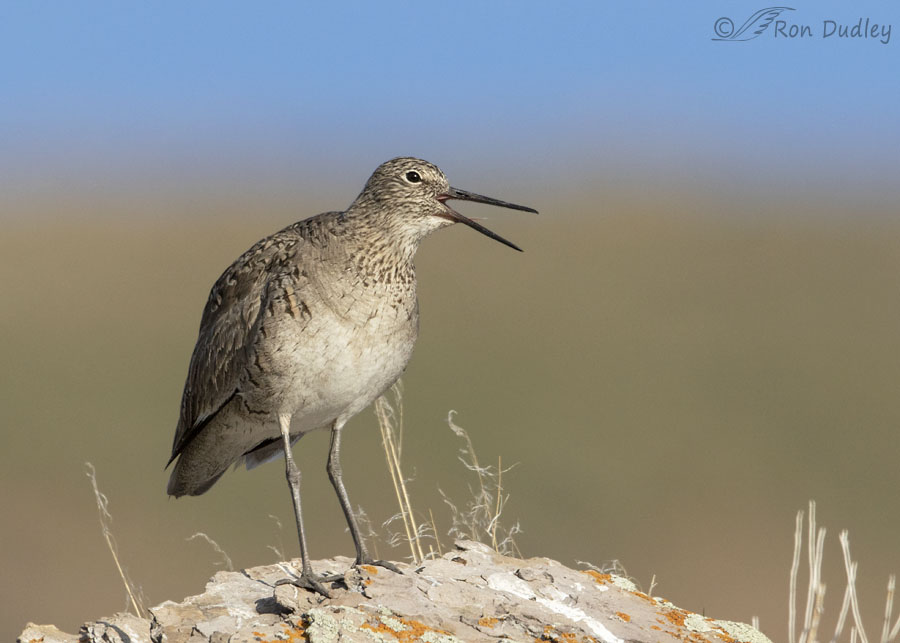
1/3200, f/7.1, ISO 640, Canon 7D Mark II, Canon EF 500mm f/4L IS II USM + EF 1.4 III Extender, not baited, set up or called in
I always look forward to the return of our Western Willets. I’ve been hearing their distinctive calls from far off for a couple of weeks now but until five days ago when I found this bird in northern Utah’s high desert I’d never been able to get close enough for photographs.
He was perched on top of a rocky outcrop in an isolated area of Box Elder County. This time of year this outcrop has actually been a fairly reliable perch for Willets for several years now. They find an elevated perch like this one and often return to it regularly even though it isn’t particularly close to their typical watery habitat. But that only lasts for a week or two and then I don’t see them there again for the rest of the year.
This bird was calling its typical “pill-will-willet” call. It’s a loud, piercing call that the typical human observer doesn’t soon forget.
Later that same morning I was lucky enough to photograph the mating Red-tailed Hawks that I posted recently so the following morning I returned to the same area to see if I could relocate the hawks.
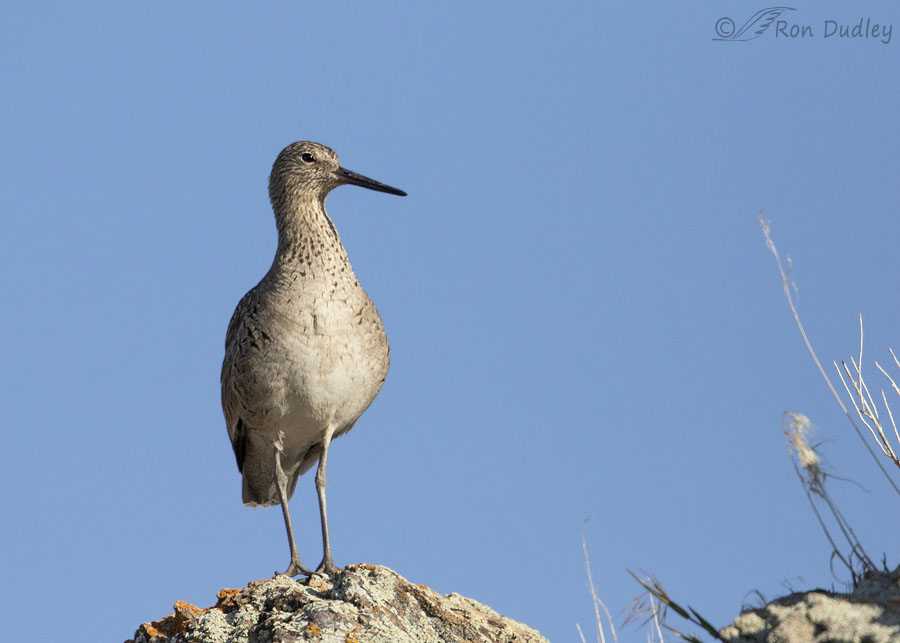
1/5000, f/6.3, ISO 500, Canon 7D Mark II, Canon EF 500mm f/4L IS II USM + EF 1.4 III Extender, not baited, set up or called in
I struck out on the red-tails but I did find the Willet on the same rocky outcrop at the same time of morning I’d photographed him the day before. This time he was on a different point of rock on the outcrop so for complicated reasons I couldn’t get anything but blue sky in the background and he was more side lit.
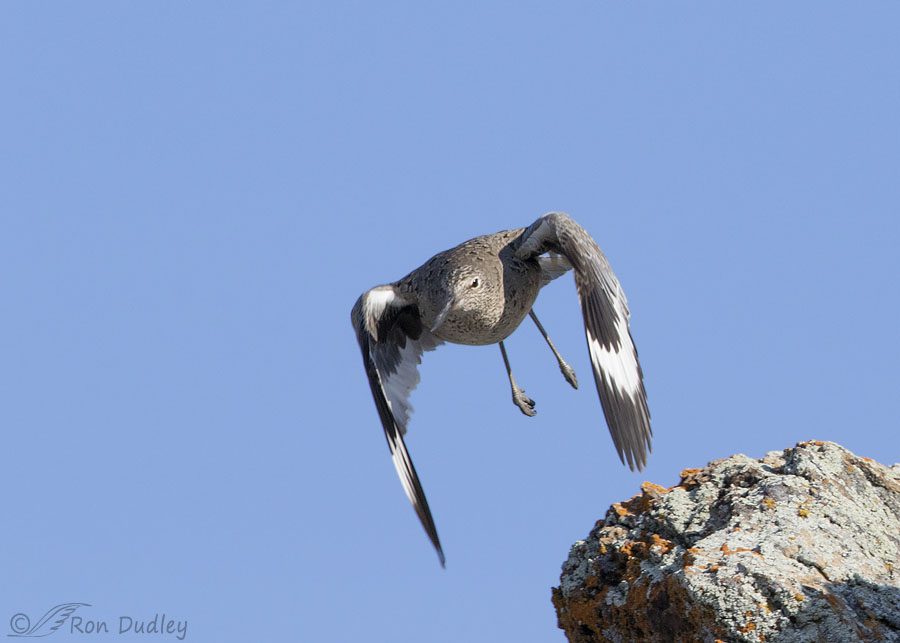
1/3200, f/6.3, ISO 640, Canon 7D Mark II, Canon EF 500mm f/4L IS II USM + EF 1.4 III Extender, not baited, set up or called in
I did manage to get a few flight shots when he took off.
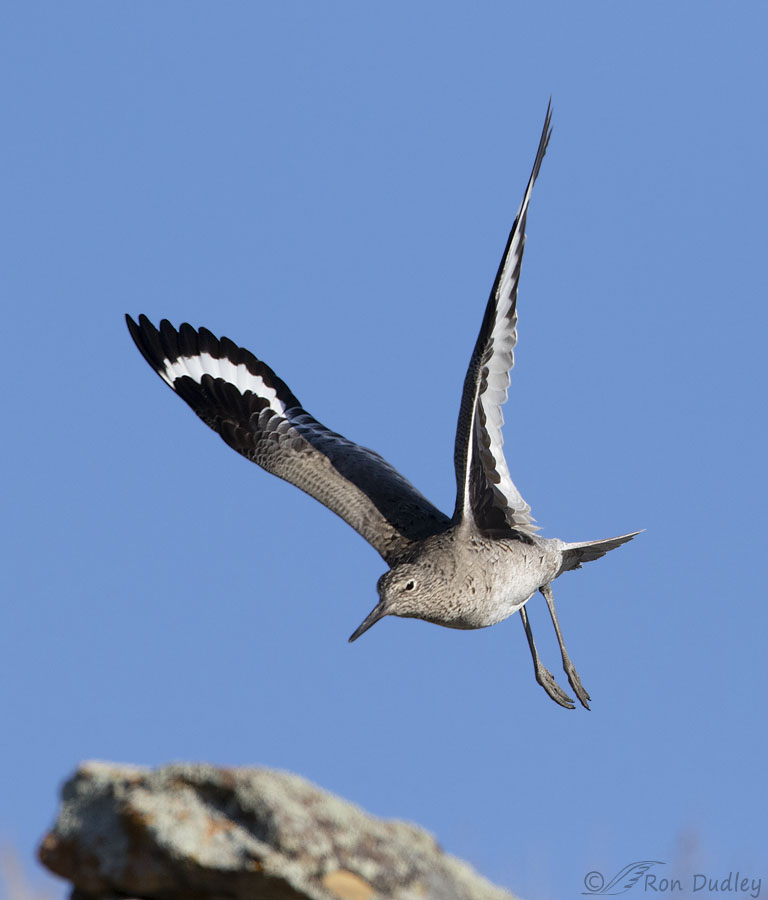
1/2500, f/6.3, ISO 640, Canon 7D Mark II, Canon EF 500mm f/4L IS II USM + EF 1.4 III Extender, not baited, set up or called in
None of them were great photos but I was able to get light in his eye and a reasonably good look at his boldly marked wings.
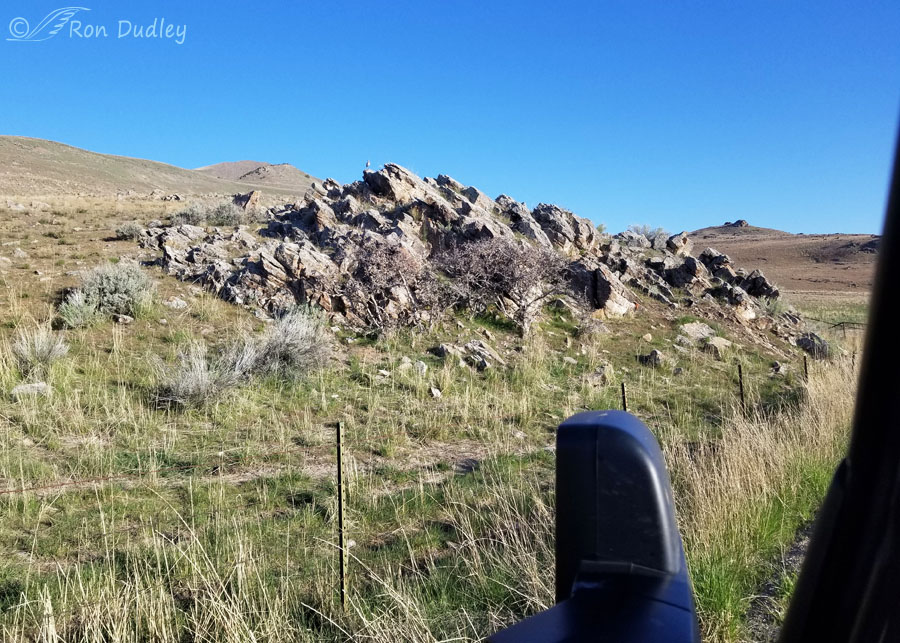
Cell phone photo
The breeding habitat of our Western Willets is markedly different than that of the Eastern Willets that many of my readers are probably more familiar with. This is the rocky outcrop I found “my willet” calling from on both mornings. This photo was taken on the second morning just before I took the flight shots posted above. Sharp eyes should be able to spot him just to the left of the highest rocky peak in the outcrop.
Because of their plain drab colors (before they raise their boldly marked wings) Willets often don’t get the attention and respect I think they deserve.
But I always look forward to their return as a sure sign of spring.
Ron
Note: Willets have evolved into two distinct populations, Western and Eastern, in part because of their very different breeding environments. This from Cornell’s Birds of the World:
- “Eastern Willets often have abundant food resources but limited nesting habitat, while Western Willets often have abundant nesting habitat but unpredictable food resources, depending on wetland availability and drought.“


Sharp eyes there young fella !!!
Hi Ron,
A great and useful series of images of a terrific bird. Their evocative calls are one of my take-away memories of North America.
Stay well.
Thanks very much, Gary. You too.
The Willet is beautiful in flight. I’m glad you saw him again.
Thanks, Jean.
I love to see the Willets every June at the Wellfleet Bay Wildlife Sanctuary in Cape Cod,. As you walk on the boardwalks through the shore grasses they really give you the business! They also sit on top of the Eastern White Cedars and make a racket. I’ll miss them if I don’t get to go this June. Our room is booked but not sure that the cape will be welcoming visitors.
I hope you can go, Joanne.
Stunning.
And (I am in philoosophical mode this morning it seems) a reminder that if we keep our eyes (and hearts and minds open) there is beauty everywhere.
Thanks Ron.
And sad to say I think I would have missed the Willet on that outcrop until he moved.
Normally I might have missed him too, EC. But because they’ve perched on that outcrop so often in past years I know to look there. Carefully.
Beautiful photos, how do you manage to capture birds without clutter in your photos? I have been hearing them but too far away for photos. This is the time of year I usually catch them at Antelope Island, but even though I can now go there I am reluctant. Crowds and gnats. Both in the same category if you ask me!
“Crowds and gnats. Both in the same category if you ask me!”
I couldn’t agree more, April. Which is why I haven’t been back since they opened it back up to “the rest of us”.
Clutter is often a problem this time of year with Willets and especially with curlews. I don’t even point my lens at them when they’re significantly buried in the vegetation unless I think some kind of interesting behavior might erupt.
Wow! Those wing markings are really something! Totally unexpected.
Good eye, catching him on that rocky outcrop.
Thanks, Marty. They’re a transformative bird when they open their wings.
Excellent flight shots Ron and an some interesting information regarding Willets. I have only seen Willets once or twice here and never in flight. I just realized yesterday that all our ducks have headed north with the exception of the Mallards, Ruddy ducks, and Gadwall. High temps right now are very close to 80. And really neat to see all the Yellow Warblers, Summer Tanagers, and flocks of American Avocets arriving.
Everett, we’re forecast to have temps in the 80’s for the last half of next week. I’m not looking forward to summer heat.
What a lovely bird. Your flight photos are awesome!!
Thank you, Cathy.
Love the first take-off photo – almost looks like a raptor! They may have trouble with prairie pot holes in our area this year after our ridiculously dry winter. Of course, heavy spring rains are still possible tho we’ve gotten very little so far….. The “perch” is interesting – I haven’t noted it here but then usually don’t see them until late summer on the low water on the creek.
They may have trouble with prairie pot holes in our area this year after our ridiculously dry winter. Of course, heavy spring rains are still possible tho we’ve gotten very little so far….. The “perch” is interesting – I haven’t noted it here but then usually don’t see them until late summer on the low water on the creek.
Judy, around here I think they’re most conspicuous this time of year (in April) when they’re on these elevated perches and calling with that loud and distinctive call.
I had no idea that western willets lived such a different existence from those in the east. The habitat you photographed is not a place I would expect to see one.
When I learned to bird in the Phoenix area, the willets were at the wastewater treatment plant settling ponds.
Pam, I may be wrong but I also get the impression that many observers of Eastern Willets have never heard the piercing “pill-will-willet” call of Willets during breeding season. It’s very distinctive from their other calls.